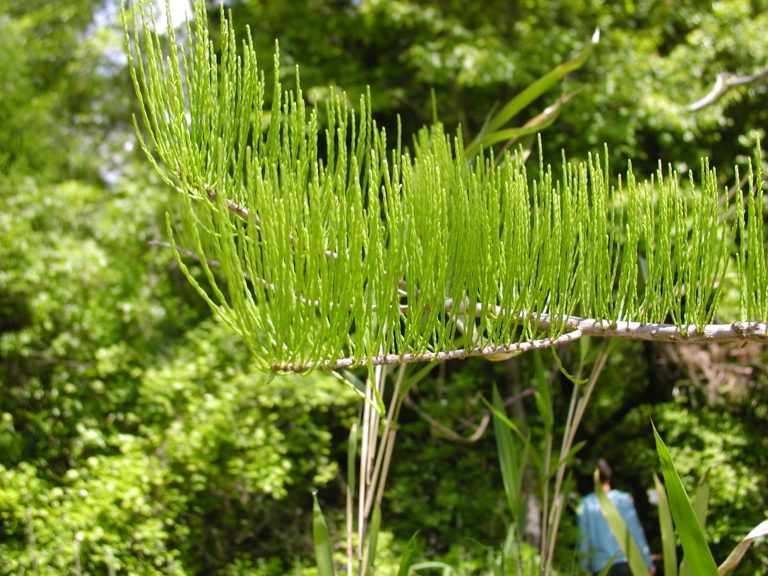Pond Cypress is a deciduous conifer of our Southeastern states which roughly resembles (and is considered by some to be a variety of) Taxodium distichum, or Bald Cypress (See our entry for T. distichum). There are similarities between the two, such as their amazing soil moisture adaptability from standing water to upland, well drained soil and their outstanding rot-resistant heartwood. But Pond Cypress has a narrower crown than Bald Cypress, and is smaller; it is less likely than Bald Cypress to have knees; its fluted base tends to have rounded rather than sharp ridges; its branches are more ascending than those of Bald Cypress and its needle-like leaves are appressed rather than laterally oriented. Pond Cypress also is found growing more on the edges of ponds, rather than in the ponds. The distribution of Pond Cypress is far less widespread than that of Bald Cypress. Pond Cypress occurs in the southern portion of the range of Bald Cypress and only on the southeastern coastal plain from North Carolina into Louisiana, whereas Bald Cypress extends on into Texas and up the Mississippi Valley to Missouri, Illinois and Indiana. With its delicate foliage and light, dappled shade, its bright copper fall foliage, its pronounced verticality, its persistent fruits and showy winter trunk, this species could be used far more than it has been for its purely ornamental features.
NURSERY HOURS
Wednesday: 10-4 Thursday: 10-6 Friday-Saturday: 10-4 Sunday: 12-4
Taxodium ascendens

Key Info
Scientific Name: Taxodium ascendens Brongn. syn.Taxodium distichum (L.) Rich. var. imbricarium (Nutt.) Croom
Common Names: Pond Cypress, White Cypress, Gulf Cypress, Southern Cypress, Red Cypress, Swamp Cypress, Yellow Cypress, Dwarf Cypress, Hat-rack Cypress
Family Names: Cupressaceae (Cypress Family)
Plant Type: Tree / Shrub
Leaf Retention: Deciduous
Flower Color: Brown (cones rather than flowers)
Additional Info
Habit: Very straight-trunked, with horizontal branches and deciduous branchlets ascend vertically from branches. The crown is cylindrical, becoming irregular with age. The trunk is usually buttressed. Pond Cypress is less likely to have knees than Bald Cypress, but does have them when grown in wet areas, though smaller and more rounded. The bark is reddish brown and deeply furrowed, fibrous and shreddy. Pond Cypress develops a taproot as well as horizontal roots.
Height: 50-60' (up to 80')
Spread: 10' - 15'
Soil Conditions: Prefers moist, acidic, sandy soils, but actually tolerates a wide range of soil conditions ranging from average moisture soils to wet soils in some standing water.
Leaves: Bright green, spirally arranged, simple, entire, linear or awl like, 3/8 inch long, appressed to the twig, green to yellow-green, showy copper color in fall.
Flowers (or reproductive structures: Pond Cypress is monoecious. Male flowers are in 3- to 5-inch long slender, drooping panicles, nearly full grown in the summer preceding their opening, very conspicuous in winter, shedding pollen March-April; female cones nearly spherical, shedding seeds in October.
Fruit: Nearly round cone with peltate scales, 3⁄4 to 1 inch in diameter, initially yellow-green but turning brown and breaking into individual scales when mature, Oct - Dec. (Virginia Tech Dendrology).
Natural Distribution: Pond Ccypress occurs in blackwater rivers, ponds, lake margins, bayous, and swamps, usually without alluvial flood deposits.
USDA Hardiness Zone: 5 to 9
USDA Wetland Indicator Status in NC: OBL
Pollination: Wind
Wildlife Connections: Excellent habitat/cover for birds; attracts squirrels and other mammals. Seeds are a food source for birds and small mammals, such as wild turkey, wood ducks, evening grosbeak, and squirrels.
Propagation: Pond Cypress seedlings cannot compete with other vegetation in upland sites, and thus rely on the wetland environment for successful reproduction in the wild. However, stratified seeds will germinate abundantly in moist soil where competition is controlled.
